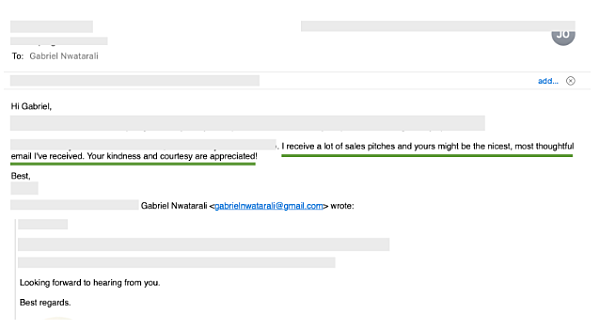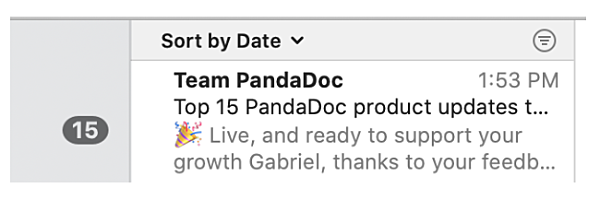Thanks to advanced email marketing tools such as Keap, we can know what’s happening with our cold emails. But do you ever wonder why prospects open your emails but never respond? If so, you’re not alone. Many salespeople, entrepreneurs, freelancers, etc., ponder the same issue. The good news is you found this article before swearing off cold emailing forever due to a practically nonexistent response rate. Today you’ll learn why your response rate is too low and how to write cold emails that get responses.
Obviously, you can’t make everyone happy and trying to do so isn’t worth the headache. The goal of this article is to show you how to raise your reply rate. You see, cold emailing is like cold calling. You’re reaching out to people who know nothing about you or your company in hopes that they’ll become interested.
And if you get it right, cold email outreach is a powerful lead generation and sales tool. Many new companies depend on cold email outreach for growth during the early stages.
Why it feels like cold email doesn’t work
To understand why too many prospects are ignoring your emails, let’s take a look at the workplace. A study from the University of Waterloo found that the primary reason people deferred emails were as follows.
- The time or effort required to handle the email
- The sender’s identity
- The total number of email recipients
- The recipient’s workload and context
- The urgency of the message
In most cases, you’re reaching your prospects at work and even if not, all of the aforementioned reasons apply. Cold email outreach is about communicating with and influencing people. This is easier to do when each prospect is approached with the sincere intention of helping them.
Sometimes marketers and salespeople forget they’re dealing with other people with feelings and their own challenges in life. Start viewing your prospects as more than a number to get more responses. In other words, you need to introduce empathy to your cold emails. That’s what it all boils down to.
For example, the following is a response this author received from a person that appreciated the empathy shown.

Avoid randomly scraping emails from the web and sending a pitch to everyone even though many aren’t qualified to begin with. And don't be overly focused on yourself and what you want. Instead, take the time necessary to qualify your prospects and craft emails that come from a place of empathy, not selfishness.
Use the following tips to increase your cold email marketing campaign response rate.
1. Have a great email signature
Most prospects use your signature as a trust indicator. Your signature shouldn’t distract from the copy but it has to prove you’re a real person that can be trusted. Remember that this is the first email the recipient is getting from you so make sure their “Spidey senses” don’t get triggered.
Good signatures are short and include the following details:
- Full name
- Job or profession title
- Phone number
- Website address or other online profile (e.g. LinkedIn)
- A photo of you (better) or company logo (decent)
2. Reach the right audience
You have to know your prospects to make sure you’re reaching the right people. This is true for any marketing campaign.
A common thought process is that to win business you have to reach the big boss or final decision maker. While this may be true in some situations, it isn’t in most. Companies have several individuals that handle different areas of the business. You’ll get better results by reaching the person in charge of the department that corresponds to your area of business.
For example, a salesperson that is selling POS (point of sale) systems to restaurants can schedule a free demo with the General Manager (GM). The GM is the person that can influence the owners or others above them about adopting the product. So they have to love it first.
You want the person that’ll most likely listen and move your offer up the chain of command. This way, you’re also giving them the opportunity to be a hero. Top executives love resourceful people who are able to identify what the company needs.
Keap’s powerful Campaign Builder can be configured any way you need it, then get to work automatically capturing new leads, assigning tasks, and sending emails that nurture new leads. Try it out for free here: https://t.co/sKEbAZr8yJ pic.twitter.com/uxfFsfzQKD
— Keap (@KeapGrowing) February 17, 2020
3. Write a great subject line
Really put some thought into your subject line. This is the first thing the recipient sees and what they’ll use to decide whether or not to open your cold email. No one will consider doing business with you if they never read the email copy.
Think of your subject line as the email headline, similar to articles, newspaper ads, blog posts, etc. It has to entice the consumer enough to move forward. In fact, there isn’t a lot of difference between an email subject line and other headlines.
Any effective email subject line should have at least one or more of the following elements:
- Personalization – Everyone wants to be seen as an individual
- Curiosity – People are curious by nature
- Promise – We generally want to know what’s in it for us
- Implied instant gratification – We prefer to be gratified sooner than later
- Humor – Laughter is like medicine and we love people that can make us laugh
- Urgency – FOMO (fear of missing out) can compel recipients to read your emails
Here are some quick subject line examples that touch on each of the aforementioned elements in order:
- “You’ve Changed” – This subject line was used in a campaign by UrbanDaddy
- “Don’t Open This Email” – Manicube
- “Get more kitchen space with these easy fixes” – IKEA
- “14.2 pounds gone in just 1 week (here’s how)” – Healthpreneur
- “Licking your phone never tasted so good” – OpenTable
- “Tonight only: A denim lover’s dream” – Guess
Just make sure you use this knowledge for good Padawan (Yes, that’s a Star Wars reference).
4. Optimize the opening line
There are two reasons why your email copy’s opening line is critical. First, the opening line is what the recipient sees as a preview on their email client.

Second, your opening line has to capture/hold the interest of your prospect.
Avoid beginning with something that may make the reader disinterested. For example, you don’t have to begin your email with “Hello, my name is” even though an introduction is necessary. A better approach would be something like “Noticed you offer landscaping services in Atlanta and thought I'd introduce myself."
The goal is to hold their interest long enough to read past the first sentence. After that point, the recipient is paying attention. So if your email copy is well-written, they’ll most likely read the rest of it. That being noted, always aim to hold attention throughout your copy.
One more thing on the opening line.
It’s not “black and white” or without complexity. In some situations, it may be appropriate to start with “Hello, my name is."
5. Add social proof
Social proof is a psychological phenomenon where people mimic the actions of others as a shortcut toward making the right decisions.
Any social proof you can provide is helpful but the most common is to use previous customers. Provide names of previous clients or brands that you’ve worked with, if possible. Otherwise, you have other options that are just as good such as the following:
- Use customer testimonials
- Mention the number of users currently using your product
- Share your past work (e.g. portfolio, samples)
- Include a link to your awesome customer reviews
- Add a celebrity or expert endorsement you’ve received
- Show off your credentials such as certifications or an online course you created
- Add a link to featured appearances such as an article or interview
- Share a case study
Spend some time thinking about ways to show social proof in your email.
6. Keep the email short
Time is valuable. Your prospect probably deals with multiple things on a daily basis and they’re most likely receiving emails from others. So, keep your emails short and to the point unless you've already established a relationship with the person.
Also, a short cold email shows the recipient that you don’t intend to waste their time. Hence, they’ll likely be more willing to pay attention.
7. Close strong
Good email closes have a clear CTA (call-to-action) and attempt to lead the prospect toward identifying value or need.
Ask questions that can help the prospect identify a use for your products or services. For example, a cleaning company could write something like, “Does being able to start working without having to clean up each day sound good to you? If so, please click here to schedule a free discovery call with me."
The objective is to use questions to trigger a yes or no response from the recipient and immediately tell them exactly what to do next. Here’s another example: “Are you available for a quick 15-minute chat this week? Just click here to quickly book a call."
The examples above are using closed-ended questions that trigger a yes or no response but you can also use open-ended questions. These types of questions are powerful and providing that you’re reaching the right prospects, most will respond.
For example, a SaaS (software as a service) company offering SEO tools could use something like, “Please allow me to show you how (insert tool name) can double your organic traffic. What are your current expectations from doing SEO?”
A bit of empathy can do wonders
Cold emailing is still one of the more powerful and cost-effective ways to reach potential customers. You just have to understand the science behind it. Email writing is an art form that requires a basic understanding of human psychology. However, nothing is “set in stone” when it comes to crafting cold emails. If you want higher response rates, start introducing a bit more empathy.
About the author
Gabriel Nwatarali is the founder of Tech Help Canada and a digital marketing specialist with a passion for SEO (search engine optimization). He regularly contributes his knowledge of online marketing, business, and technology to online publications.


